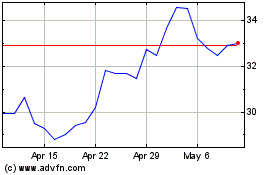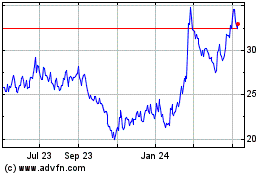Agios Pharmaceuticals, Inc. (NASDAQ:AGIO), a leader in the field of
cellular metabolism to treat cancer and rare genetic diseases,
today announced that the U.S. Food and Drug Administration (FDA)
has granted Breakthrough Therapy designation for TIBSOVO®
(ivosidenib) in combination with azacitidine for the treatment of
newly diagnosed acute myeloid leukemia (AML) with an IDH1 mutation
in adult patients who are ≥75 years old or who have comorbidities
that preclude use of intensive induction chemotherapy.
“Outcomes for newly diagnosed AML patients ineligible for
intensive chemotherapy are still poor, and there are no approved
options specifically for patients with an IDH1 mutation,” said
Chris Bowden, M.D., chief medical officer at Agios. “The
Breakthrough Therapy designation provides further support that
combining azacitidine and ivosidenib for these patients has the
potential to be a compelling treatment option.”
The FDA's Breakthrough Therapy designation is intended to
expedite the development and review of a drug candidate that is
planned to treat a serious or life-threatening disease or condition
when preliminary clinical evidence indicates that the drug may
demonstrate substantial improvement over available therapies on one
or more clinically significant endpoints.
Results from the Phase 1/2 study of ivosidenib in combination
with azacitidine were last presented at the 17th International
Symposium on Acute Leukemias in Munich. In the ivosidenib arm of
the Phase 1b portion of the study, 23 patients received 500 mg of
ivosidenib daily plus azacitidine. The median age was 76 years old,
and 52% of patients were age 75 or older. The safety profile of
combination therapy remains consistent with the safety profile of
ivosidenib and azacitidine alone in this patient population. As of
the August 1, 2018 data cutoff, mean neutrophil and platelet counts
were maintained near or above thresholds for complete response (CR)
with partial hematologic recovery (CRh) while on study treatment
with ivosidenib and azacitidine. Overall, 78% (18/23) of patients
had a response and 57% (13/23) of patients had a CR. The median
duration of CR had not been reached (95% CI 7.7, NE). In addition,
the 12-month survival rate was 82%.
Ivosidenib is not approved in any country for the treatment of
patients with newly diagnosed AML or approved in combination with
azacitidine.
About TIBSOVO® (ivosidenib)
TIBSOVO® (ivosidenib) is an isocitrate
dehydrogenase-1 (IDH1) inhibitor indicated for the treatment of
adult patients with relapsed or refractory acute myeloid leukemia
(AML) with a susceptible IDH1 mutation as detected by an
FDA-approved test. For more information, visit TIBSOVO.com.
IMPORTANT SAFETY INFORMATION
|
WARNING: DIFFERENTIATION SYNDROMEPatients
treated with TIBSOVO have experienced symptoms of differentiation
syndrome, which can be fatal if not treated. Symptoms may include
fever, dyspnea, hypoxia, pulmonary infiltrates, pleural or
pericardial effusions, rapid weight gain or peripheral edema,
hypotension, and hepatic, renal, or multi-organ dysfunction. If
differentiation syndrome is suspected, initiate corticosteroid
therapy and hemodynamic monitoring until symptom
resolution. |
WARNINGS AND PRECAUTIONS
Differentiation Syndrome: See Boxed WARNING. In
the clinical trial, 19% (34/179) of patients with relapsed or
refractory AML treated with TIBSOVO experienced differentiation
syndrome. Differentiation syndrome is associated with rapid
proliferation and differentiation of myeloid cells and may be
life-threatening or fatal if not treated. Symptoms of
differentiation syndrome in patients treated with TIBSOVO included
noninfectious leukocytosis, peripheral edema, pyrexia, dyspnea,
pleural effusion, hypotension, hypoxia, pulmonary edema,
pneumonitis, pericardial effusion, rash, fluid overload, tumor
lysis syndrome, and creatinine increased. Of the 34 patients who
experienced differentiation syndrome, 27 (79%) recovered after
treatment or after dose interruption of TIBSOVO. Differentiation
syndrome occurred as early as 1 day and up to 3 months after
TIBSOVO initiation and has been observed with or without
concomitant leukocytosis.
If differentiation syndrome is suspected, initiate dexamethasone
10 mg IV every 12 hours (or an equivalent dose of an alternative
oral or IV corticosteroid) and hemodynamic monitoring until
improvement. If concomitant noninfectious leukocytosis is observed,
initiate treatment with hydroxyurea or leukapheresis, as clinically
indicated. Taper corticosteroids and hydroxyurea after resolution
of symptoms and administer corticosteroids for a minimum of 3 days.
Symptoms of differentiation syndrome may recur with premature
discontinuation of corticosteroid and/or hydroxyurea treatment. If
severe signs and/or symptoms persist for more than 48 hours after
initiation of corticosteroids, interrupt TIBSOVO until signs and
symptoms are no longer severe.
QTc Interval Prolongation: Patients treated
with TIBSOVO can develop QT (QTc) prolongation and ventricular
arrhythmias. One patient developed ventricular fibrillation
attributed to TIBSOVO. Concomitant use of TIBSOVO with drugs known
to prolong the QTc interval (e.g., anti-arrhythmic medicines,
fluoroquinolones, triazole anti-fungals, 5-HT3 receptor
antagonists) and CYP3A4 inhibitors may increase the risk of QTc
interval prolongation. Conduct monitoring of electrocardiograms
(ECGs) and electrolytes. In patients with congenital long QTc
syndrome, congestive heart failure, electrolyte abnormalities, or
in those who are taking medications known to prolong the QTc
interval, more frequent monitoring may be necessary.
Interrupt TIBSOVO if QTc increases to greater than 480 msec and
less than 500 msec. Interrupt and reduce TIBSOVO if QTc increases
to greater than 500 msec. Permanently discontinue TIBSOVO in
patients who develop QTc interval prolongation with signs or
symptoms of life-threatening arrhythmia.
Guillain-Barré Syndrome: Guillain-Barré
syndrome occurred in <1% (2/258) of patients treated with
TIBSOVO in the clinical study. Monitor patients taking TIBSOVO for
onset of new signs or symptoms of motor and/or sensory neuropathy
such as unilateral or bilateral weakness, sensory alterations,
paresthesias, or difficulty breathing. Permanently discontinue
TIBSOVO in patients who are diagnosed with Guillain-Barré
syndrome.
ADVERSE REACTIONS
- The most common adverse reactions (≥20%) of any grade were
fatigue (39%), leukocytosis (38%), arthralgia (36%), diarrhea
(34%), dyspnea (33%), edema (32%), nausea (31%), mucositis (28%),
electrocardiogram QT prolonged (26%), rash (26%), pyrexia (23%),
cough (22%), and constipation (20%).
- The most frequently reported ≥Grade 3 adverse reactions (≥5%)
were electrocardiogram QT prolonged (10%), dyspnea (9%),
leukocytosis (8%), tumor lysis syndrome (6%), and differentiation
syndrome (5%).
- Serious adverse reactions (≥5%) were differentiation syndrome
(10%), leukocytosis (10%), and electrocardiogram QT prolonged (7%).
There was one case of progressive multifocal leukoencephalopathy
(PML).
DRUG INTERACTIONS
Strong or Moderate CYP3A4
Inhibitors: Reduce TIBSOVO dose with strong CYP3A4
inhibitors. Monitor patients for increased risk of QTc interval
prolongation.
Strong CYP3A4 Inducers: Avoid concomitant
use with TIBSOVO.
Sensitive CYP3A4 Substrates: Avoid concomitant
use with TIBSOVO.
QTc Prolonging Drugs: Avoid concomitant use
with TIBSOVO. If co-administration is unavoidable, monitor patients
for increased risk of QTc interval prolongation.
LACTATION
Many drugs are excreted in human milk and because of the
potential for adverse reactions in breastfed children, advise women
not to breastfeed during treatment with TIBSOVO and for at least 1
month after the last dose.
Please see full Prescribing Information, including Boxed
WARNING.
About Acute Myelogenous Leukemia (AML)AML, a
cancer of blood and bone marrow characterized by rapid disease
progression, is the most common acute leukemia affecting adults.
Undifferentiated blast cells proliferate in the bone marrow rather
than mature into normal blood cells. AML incidence significantly
increases with age, and the median age of diagnosis is 68. The vast
majority of patients do not respond to chemotherapy and progress to
relapsed/refractory AML. The five-year survival rate for AML is
approximately 27 percent. IDH1 mutations are present in about 6 to
10 percent of AML cases.
About AgiosAgios is focused on discovering and
developing novel investigational medicines to treat cancer and rare
genetic diseases through scientific leadership in the field of
cellular metabolism. In addition to an active research and
discovery pipeline across both therapeutic areas, Agios has two
approved oncology precision medicines and multiple first-in-class
investigational therapies in clinical and/or preclinical
development. All Agios programs focus on genetically identified
patient populations, leveraging our knowledge of metabolism,
biology and genomics. For more information, please visit the
company's website at www.agios.com.
Cautionary Note Regarding Forward-Looking
StatementsThis press release contains forward-looking
statements within the meaning of The Private Securities Litigation
Reform Act of 1995. Such forward-looking statements include those
regarding the potential benefits of TIBSOVO® (ivosidenib); and the
benefit of Agios’ strategic plans and focus. The words
"expects," "anticipates," "believes," "intends," "estimates,"
"plans," "will," "outlook" and similar expressions are intended to
identify forward-looking statements, although not all
forward-looking statements contain these identifying words.
Such statements are subject to numerous important factors, risks
and uncertainties that may cause actual events or results to differ
materially from Agios' current expectations and beliefs. For
example, the FDA’s Breakthrough Therapy designation for TIBSOVO®
(ivosidenib) in combination with azacitidine is not a guarantee of
approval. Management's expectations and, therefore, any
forward-looking statements in this press release could also be
affected by risks and uncertainties relating to a number of other
important factors, including: Agios' results of clinical trials and
preclinical studies, including subsequent analysis of existing data
and new data received from ongoing and future studies; the content
and timing of decisions made by the U.S. FDA, the EMA or other
regulatory authorities, investigational review boards at clinical
trial sites and publication review bodies; Agios' ability to obtain
and maintain requisite regulatory approvals and to enroll patients
in its planned clinical trials; unplanned cash requirements and
expenditures; competitive factors; Agios' ability to obtain,
maintain and enforce patent and other intellectual property
protection for any product candidates it is developing; Agios'
ability to maintain key collaborations, such as its agreements with
Celgene and CStone Pharmaceuticals; and general economic and market
conditions. These and other risks are described in greater detail
under the caption "Risk Factors" included in Agios’ public filings
with the Securities and Exchange Commission. Any forward-looking
statements contained in this press release speak only as of the
date hereof, and Agios expressly disclaims any obligation to update
any forward-looking statements, whether as a result of new
information, future events or otherwise, except as required by
law.
Investor & Media ContactHolly Manning,
617-844-6630Associate Director, Investor
RelationsHolly.Manning@agios.com
Agios Pharmaceuticals (NASDAQ:AGIO)
Historical Stock Chart
From Mar 2024 to Apr 2024

Agios Pharmaceuticals (NASDAQ:AGIO)
Historical Stock Chart
From Apr 2023 to Apr 2024
